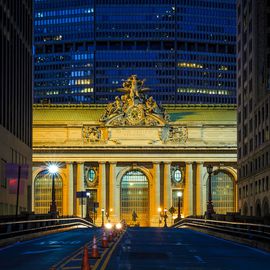

Grand Central Terminal, besides being the biggest railway station in the world with forty-four platforms, sixty-seven tracks, about three hundred daily departures and over twenty million annual visitors, is a formidable work of architecture.
The first train station to stand on this spot was called the Grand Central Depot, which was built in 1871 by railroad magnate Cornelius Vanderbilt as a New York terminus for his national railways. In 1900 the Depot was torn down, the railroad tracks on Park avenue south of 42nd Street were removed and a new building was erected, the Grand Central Station. Several years later the Station was also demolished and in 1913 replaced with what we see today, the Grand Central Terminal.
The building was designed by two firms: Reed and Stern, and Warren and Wetmore. It was built mostly out of granite and stretches from 42nd to 45th Streets. It has two levels of tracks: the Main Concourse, and the Dining Concourse below with the lower set of tracks. The most striking element of the upper level is its ceiling. Called the Astronomical Ceiling because it shows the major constellations, such as Pisces, Taurus, Gemini, etc., it was designed by French painter Paul Cesar Helleu in 1912. In the 1930s it was heavily renovated, losing its initial brilliance. Only in 1998, after a twelve-year renovation, was it again possible to clearly see the original golden filigree figures against the Malachite green background.
Outside, above the 42nd Street entrance, above the viaduct going around the terminal, rises the statue of Hercules, Minerva and Mercury, the embodiments of strength, wisdom and commercial acumen. It was designed by French sculptor Jules-Felix Coutan and unveiled in 1914. Nestled in the center of the statue is a four-meter clock made out of Tiffany glass, the largest work of such material. Right below the sculpture, standing on a marble pedestal, is a bronze statue of Cornelius Vanderbilt.
Grand Central, as it is usually called by New Yorkers, serves lines heading to upstate New York and Connecticut, and until 1991 it was the New York terminal for America's biggest railway, Amtrak. Amtrak then moved to Penn Station, Grand Central's rival a few blocks south. Inside, both on the Main and Lower Concourse we will find some excellent restaurants. The most popular, however, is the Grand Central Oyster Bar on the lower level. Established in 1913, it has become one of the jewels of the New York culinary world. With the slogan "The Freshest Seafood in Manhattan," it does indeed offer the best and the widest variety of oysters coming from all over the world. It was so popular that a replica was opened in Tokyo, Japan, bringing the spirit of New York all the way to the other side of the globe.